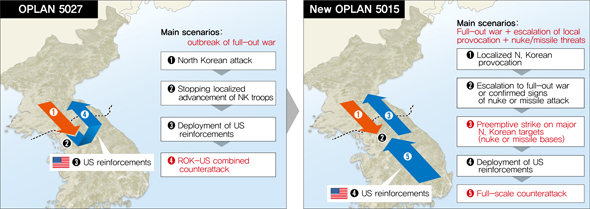Posted on : Aug.28,2015 16:30 KSTModified on : Aug.28,2015 16:30 KST
 |
OPLAN 5027 and new OPLAN 5015 |
New plan reportedly to allow the two sides to respond more effectively to a local outbreak of war with N. Korea
US and South Korean military officials have reportedly created a new operation plan - called OPLAN 5015 - predicated on a crisis situation on the Korean Peninsula. The new plan is said to adapt to changes in the security environment by focusing on making a swifter and more aggressive military response than the previous OPLAN 5027 and incorporating the concept of a preemptive strike.
On Aug. 27, a source in the military said that South Korean Joint Chiefs of Staff Chairman Choi Yoon-hee and Combined Forces Commander Curtis Scaparrotti had signed OPLAN 5015, the new plan that was drafted this plan June.
“The operation plan to which the two sides have agreed outlines how US and South Korean forces would operate during the outbreak of war or some other crisis. By the end of the year, the two sides will draw up detailed instructions for each echelon and their subordinate units according to the new operation plan,” the source said.
Reportedly, OPLAN 5015 is supposed to take effect next year.
OPLAN 5015 was a follow-up measure to Strategic Planning Guidance (SPG), which the US Secretary of Defense and the South Korean Defense Minister agreed to during the 42nd US-ROK Security Consultative Meeting (SCM) in Oct. 2010. SPG was part of efforts to draw up a new operation plan that would represent a comprehensive response to the North Korean threat and changes in the security situation.
At the time, drawing up a new operation plan was particularly important because there was a scheduled transfer of wartime operational control (OPCON) to South Korea of its forces at the end of 2015. Last year, US and South Korean military authorities agreed to delay the OPCON transfer until the mid-2020s, but OPLAN 5015 went ahead as originally planned.
According to sources, the focus of OPLAN 5015 is on enabling US-ROK forces to respond militarily to changes in the security environment, including local provocations by North Korea and the growing threat of the North’s weapons of mass destruction, including missiles and nuclear bombs.
“With North Korea’s localized provocations becoming more regular recently, there is an increasing risk of escalation. My understanding is that OPLAN 5015 explores ways to respond to these threats with US-ROK combined forces and, in the event of escalation, to respond to the threat of North Korea‘s missiles and nuclear weapons,” a military source said.
The previous operation plan - OPLAN 5027 - largely presumed a full-out war in which North Korea invaded the South and consisted of six stages corresponding to that scenario. Under this plan, if North Korean forces launched a surprise attack, the US and South Korea would hold back North Korean troops at defensive positions north of Seoul until the arrival of US reinforcements. At this point, they would establish a battle line and launch a counterattack.
During the drafting of OPLAN 5015, however, military planners appear to have considered what protocol US-ROK combined forces should follow when responding to localized provocations by North Korea, considering the increased risk of such provocations escalating into war.
In Mar. 2013, the military had already announced drawn up plans for US and South Korean forces jointly responding to localized provocations. But OPLAN 5015 appears to reflect how circumstances have changed since those plans were agreed to.
OPLAN 5015 also reportedly incorporates the South Korean military’s concept of a “kill chain,” which refers to making a preemptive strike against North Korean nuclear bombs or missiles within 30 minutes of detecting signs of an imminent launch.
“Nuclear bombs and missiles are weapons that cause immense and irreversible damage. Eliminating the threat of these weapons before they are launched is not a preemptive strike, but an act of self-defense,” a military source said.
In related news, Cho Sang-ho, a Defense Ministry official tasked with structural reform of the military, sparked controversy with a statement that he distributed before attending an academic seminar on security organized by the Korea Defense and Security Forum (KODEF) and held on Thursday at the National War Museum. In the statement, Cho said “the South Korean military will take the lead in developing concepts of asymmetric strategy that are superior to those of the North Korean military” and mentioned psychological warfare, information superiority, the ability to make precision strikes, and a “decapitation strike.”
A decapitation strike is the idea of preventing a nuclear attack during a crisis when there are indications that an enemy is preparing to use a nuclear weapon by eliminating the person with the authority to approve the attack.
Experts are concerned that the news may put a damper on the mood for dialogue, which North and South Korea barely managed to establish after refraining from a potential military clash.
By Park Byong-su, senior staff writer
Please direct questions or comments to [english@hani.co.kr]

